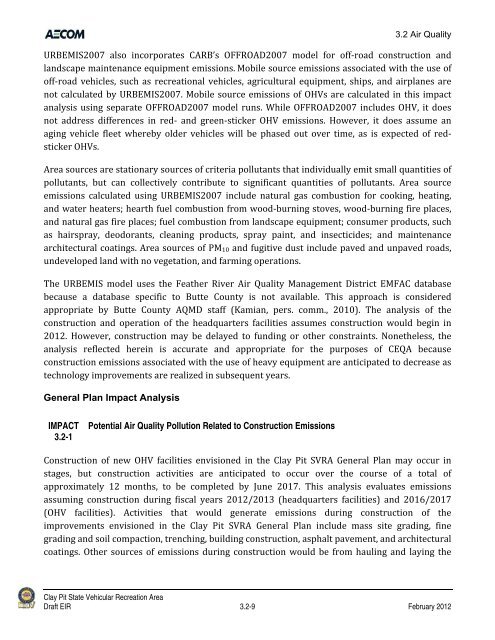Draft Environmental Impact Report - California Off Highway Vehicle ...
Draft Environmental Impact Report - California Off Highway Vehicle ...
Draft Environmental Impact Report - California Off Highway Vehicle ...
You also want an ePaper? Increase the reach of your titles
YUMPU automatically turns print PDFs into web optimized ePapers that Google loves.
3.2 Air Quality<br />
URBEMIS2007 also incorporates CARB’s OFFROAD2007 model for off‐road construction and<br />
landscape maintenance equipment emissions. Mobile source emissions associated with the use of<br />
off‐road vehicles, such as recreational vehicles, agricultural equipment, ships, and airplanes are<br />
not calculated by URBEMIS2007. Mobile source emissions of OHVs are calculated in this impact<br />
analysis using separate OFFROAD2007 model runs. While OFFROAD2007 includes OHV, it does<br />
not address differences in red‐ and green‐sticker OHV emissions. However, it does assume an<br />
aging vehicle fleet whereby older vehicles will be phased out over time, as is expected of red‐<br />
sticker OHVs.<br />
Area sources are stationary sources of criteria pollutants that individually emit small quantities of<br />
pollutants, but can collectively contribute to significant quantities of pollutants. Area source<br />
emissions calculated using URBEMIS2007 include natural gas combustion for cooking, heating,<br />
and water heaters; hearth fuel combustion from wood‐burning stoves, wood‐burning fire places,<br />
and natural gas fire places; fuel combustion from landscape equipment; consumer products, such<br />
as hairspray, deodorants, cleaning products, spray paint, and insecticides; and maintenance<br />
architectural coatings. Area sources of PM10 and fugitive dust include paved and unpaved roads,<br />
undeveloped land with no vegetation, and farming operations.<br />
The URBEMIS model uses the Feather River Air Quality Management District EMFAC database<br />
because a database specific to Butte County is not available. This approach is considered<br />
appropriate by Butte County AQMD staff (Kamian, pers. comm., 2010). The analysis of the<br />
construction and operation of the headquarters facilities assumes construction would begin in<br />
2012. However, construction may be delayed to funding or other constraints. Nonetheless, the<br />
analysis reflected herein is accurate and appropriate for the purposes of CEQA because<br />
construction emissions associated with the use of heavy equipment are anticipated to decrease as<br />
technology improvements are realized in subsequent years.<br />
General Plan <strong>Impact</strong> Analysis<br />
IMPACT<br />
3.2-1<br />
Potential Air Quality Pollution Related to Construction Emissions<br />
Construction of new OHV facilities envisioned in the Clay Pit SVRA General Plan may occur in<br />
stages, but construction activities are anticipated to occur over the course of a total of<br />
approximately 12 months, to be completed by June 2017. This analysis evaluates emissions<br />
assuming construction during fiscal years 2012/2013 (headquarters facilities) and 2016/2017<br />
(OHV facilities). Activities that would generate emissions during construction of the<br />
improvements envisioned in the Clay Pit SVRA General Plan include mass site grading, fine<br />
grading and soil compaction, trenching, building construction, asphalt pavement, and architectural<br />
coatings. Other sources of emissions during construction would be from hauling and laying the<br />
Clay Pit State Vehicular Recreation Area<br />
<strong>Draft</strong> EIR 3.2-9 February 2012








